As faithful readers of my site will know, (Hi, Mom! Hi, Dad!) earlier this year I discovered a large snapping turtle on one of my rambles. Only the head of this turtle was visible while the rest of the body was either buried in the muck or hidden under vegetation at the end of a culvert. This fall, I checked that same culvert as I always do while passing. To my surprise, something small was moving among the decaying stems of long grasses, green cattails and smartweed. It wasn’t a frog, though. It was a tiny snapping turtle!
Snapping Turtles Hatch in Late Summer and Early Fall
According to the ROM Field Guide to the Amphibians and Reptiles of Ontario, snapping turtle eggs hatch in late August or September.
I can vouch for this as one year when I was a teen, we rescued some eggs from a nest. Raccoons had been eating the ping-pong-ball-shaped white eggs leaving only shriveled leathery fragments of shell. We knew that they would be back later that week to finish off the few remaining eggs. So we took them, kept them covered in a bucket with the same sandy soil from the nest area and waited. Sure enough a few weeks later the tiny turtles emerged. We let them go into the same swamp they would have tried to reach if they had hatched where their eggs were placed. While I wouldn’t encourage anyone to interfere with a nest now, it seemed like the right thing to do then.
The tiny turtle I had just found at the culvert was as small as those long-ago hatchlings. Its shell was also still quite soft when I gently picked it up to measure it and take its photo. I placed it back in the same spot within a minute. (I also was careful with my own health until I thoroughly washed: wild turtles can often have bacteria such as salmonella on their shells.)
The tiny snapper continued to move slowly and carefully among the dead and living vegetation. It was basically wading in the shallow water on the mud-bottom. The weather was cool (about 15 C) and the water was cold. Fortunately, I saw no sign of gulls or herons who would quickly snack on such a defenseless babe. Even a squirrel could easily eat it.
I continued on my ramble very pleased with this discovery and hoping that the little one would survive.
When Had my Snapping Turtle Hatched?
I can’t know exactly when my snapping turtle hatched. I’m sure it was this year but I’m not an expert on turtles or their physiology.
When I passed the same culvert on the way home, I checked to see if the little guy was still there. To my surprised pleasure, not only was it there, but so were two other tiny snappers!
Seeing three very juvenile turtles in one place, right beside a huge swamp full of the same type of habitat makes me very suspicious. I would not be surprised at all to find all three had only very, very recently hatched and dug their way out of their sandy nest hole. I think these tiny turtles had not yet dispersed in search of food and shelter. Which makes it even more wonderful that I happened along on the right day at the right time to see them.
I sure hope each of them finds a safe and welcoming home in the swamp. Snapping Turtles, like all turtles in Ontario, under constant threat from man and man’s associates.
Raccoons Imperil Ontario’s Turtles
Raccoons, which thrive in close proximity to people and their garbage and composters, are one of the major threats to turtle populations as they will eat entire nests of eggs.
In the Fall 2011 issue of the ROMs magazine, C. Davy describes working on turtle research at Pinery Provincial Park. To their surprise and dismay, by the end of the nesting season, “every snapping turtle nest we had found—there were hundreds—had been plundered by raccoons. Predation was so high that at most, only a very few snapping turtle eggs could be surviving to hatch. And we seriously had to wonder if any at all were surviving.”
So if you see any of these tiny turtles in Ontario, please report them to Turtle Tally and please protect them if you can. If a turtle is crossing the road, try to carry it across in the direction it was heading and then immediately let it go. (Don’t try to lift large snappers though as they can bite in defense.) And of course, don’t release pet turtles into the wild where they can introduce new diseases and compete with native species.
Related Reading
- Is This Midland Painted Turtle Injured or just Shedding Scutes?
- What Rare Ontario Turtle has Large Black Blobs on the Yellow Underside of the Shell?
- What is this Really Ugly Creature Blinking at Me from the Rattray Marsh in Mississauga, Ontario?
Join In
Have you seen any baby snappers recently? Or any of the huge ones that remind me of dinosaurs? Please share your experiences with a comment.

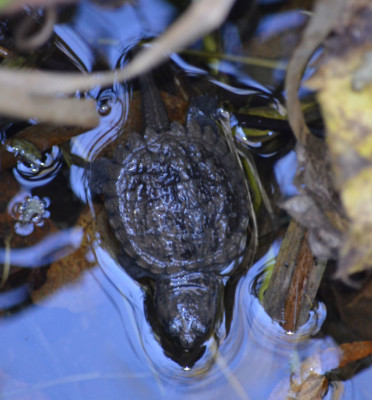
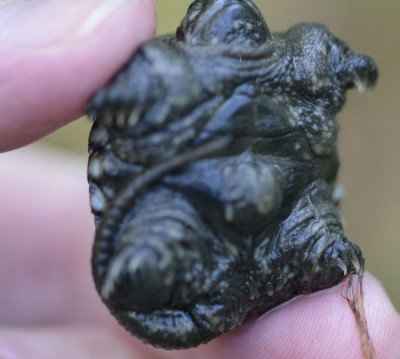
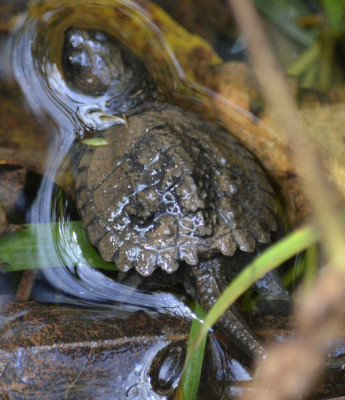
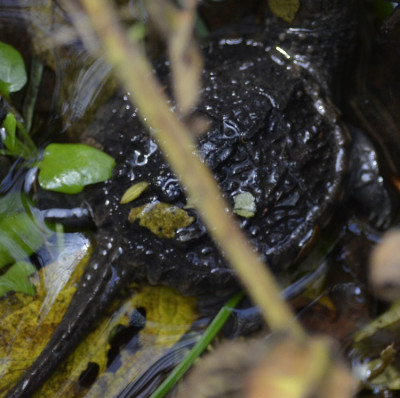
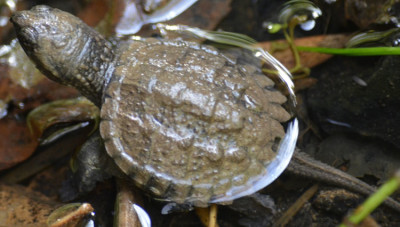
Just found a tiny snapping turtle on the sidewalk beside a gravel parking lot next to Buell’s creek in the city of Brockville, On. It appears to have an injured front left foot and was pushing itself in circles not really getting anywhere. It was covered in muck like it had just dug itself out of the nest. It’s eyes remain closed and it moves sporadically. I wasn’t sure whether to put it by the creek at the time so I did bring it home to check what it was and where it’s habitat was.
I’m sorry the turtle you found is injured. If you think it’s appropriate, you could contact a vet or an animal rescue group (like http://littleresq.net/index.php?page=home) for more information about what to do to help. Otherwise, it would be best to re-release the turtle in some ground cover (tall grasses, cattails etc.) beside the creek very close to where you found it. That’s the usual recommended practice for turtles found on roads etc.
I hope the little guy is not seriously injured. And thank you for sharing your experience.